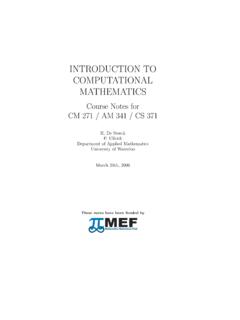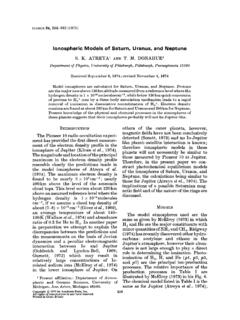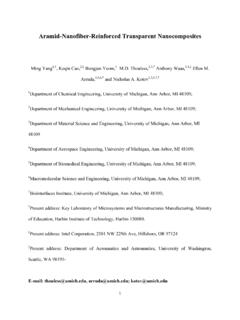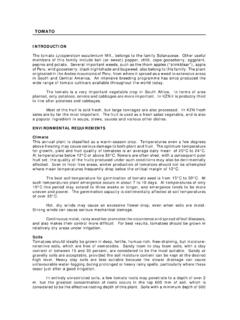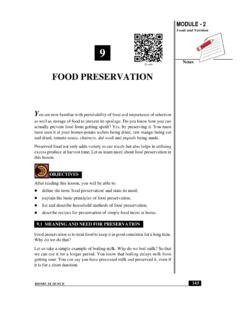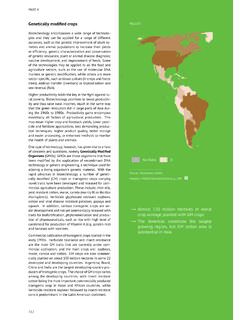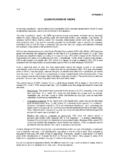Transcription of Linear Mixed Effects Models Using R
1 Andrzej Ga leckiTomasz BurzykowskiLinear Mixed Effects ModelsUsingRA Step-by-step ApproachJanuary 31, 2012 SpringerMoim bliskimVioli, Martuni, Samancie, Arturkowi, i Pawe lkowiMoim Rodzicom i NauczycielomDekadentom najbli zszym i przyjacio lom memory of Tom Ten HavePrefaceLinear Mixed -effects model (LMMs) are powerful modeling tools that allowfor the analysis of datasets with complex, hierarchical structures. Intensive re-search in the past decade has led to a better understanding oftheir growing body of literature, including recent monographs, has consider-ably increased their popularity among applied researchers.
2 There are severalstatistical software packages containing routines for LMMs. These include, forinstance, SAS, SPSS, STATA, S+, andR. The major advantage ofRis thatit is a freely available, dynamically developing, open-source environment forstatistical computing and goal of our book is to provide a description of tools available for fittingLMMs inR. The description is accompanied by a presentation of the most im-portant theoretical concepts of LMMs. Additionally, examples of applicationsfrom various areas illustrate the main features of both theory and presented material should allow readers to obtain a basic understandingof LMMs and to apply them in practice.
3 In particular, theoretical concepts andtheir practical implementation inRare presented in the context of simpler,more familiar classes of Models like, for example the classical Linear regressionmodel. Based on these concepts, more advanced classes of Models , such asmodels with correlated residual errors, are introduced. Inthis way, we incre-mentally set the stage for LMMs, so that the exposition of thetheory andRtools for these Models becomes simpler and clearer. This structure natu-rally corresponds to the object-oriented programming concept, according towhichRfunctions/methods for simpler Models are also applicable to the morecomplex assume that readers are familiar with intermediate Linear algebra, calculus,and the basic theory of statistical inference and Linear modeling.
4 Thus, theintended audience for this book are graduate students of statistics and appliedresearchers in other exposition of the theory of various classes of Models presented in the bookfocuses on concepts, which are implemented in the functionsavailable interested in a more detailed description of the theory are referred toappropriate theoretical monograph books, which we indicate in the are a large number ofRpackages, that can be used to fit LMMs. Ratherthen attempting to briefly describe all of these packages, wefocus mainly ontwo of them namely,nlmeandlme4.
5 In this way, we can provide a moredetailed account of the tools offered by the two packages, which include awide variety of functions for model fitting, diagnostics, inference, etc. Thepackagenlmeincludes functions which allow for the fitting of a wide rangeof Linear Models and LMMs. Moreover, it has been available for many yearsand its code has been stable for some time now. Thus, it is a well-establishedRtool. On the other hand, the more recent packagelme4offers an efficientcomputational implementation and an enhanced syntax, though at the costof a more restricted choice of classes of Linear Models presented in the book are illustrated Using datafrom a particular dataset.
6 In this way, the differences between the variousclasses of Models , as well as differences in theRsoftware, can be clearly delin-eated. LMMs, which are the main focus of the book, are also illustrated usingthree additional datasets, which extend the presentation of various aspects ofthe Models andRfunctions. We have decided to include the direct output ofRcommands in the text. In this way, readers who would like to repeat theanalyses conducted in the book, can directly check their ownoutput. How-ever, in order to avoid the risk of incompatibility with updated versions of thesoftware, the results of the analyses have also been summarized in the formof edited further support those readers who are interested in actively Using the mate-rial presented in the book, we have developed the packagenlmeU.
7 It containsall the datasets andRcode used in the book. The package is downloadable ~agalecki/.We hope that our book, which aims to provide a state-of-the-art descriptionof the details of implementing of LMMs inR, will support a widespread use ofthe Models by applied researchers in a variety of fields including biostatistics,public health, psychometrics, educational measurement, and working on the text, we were receiving considerable assistance and valu-able comments from many people. We would like to acknowledgeGeert Molen-berghs (Hasselt University and the Catholic University of Leuven), Geert Ver-beke (Catholic University of Leuven), Jos e Pinheiro (Novartis AG), Paul Mur-rell (Auckland University), Przemys law Biecek (Warsaw University), FabianScheipl (Ludwig Maximilian University of Munich), Jeffrey Halter (Universityof Michigan), Shu Chen (University of Michigan), Marta Ga lecka (Weill Cor-PrefaceVnell Medical College)
8 And members of the R-sig-ME discussion group led byDouglas Bates (University of Wisconsin-Madison) and Ben Bolker (McMasterUniversity), for their comments and discussions at variousstages during thepreparation of the book. We are grateful to John Kimmel for encouraging usto consider writing the book and to Marc Strauss from Springer for their edito-rial assistance and patience. We also gratefully acknowledge financial supportfrom the Claude Pepper Center grants AG08808 and AG024824 from the Na-tional Institute of Aging and from the IAP research Network P6/03 of theBelgian Government (Belgian Science Policy).
9 Ann Arbor, Michigan, USAA ndrzej T. Ga leckiDiepenbeek, Belgium, and Warszawa, PolandTomasz BurzykowskiJanuary, 2012 ContentsPart I Introduction1 Introduction.. The aim of the book .. Implementation of Linear Mixed -effects Models inR.. The structure of the book .. Technical notes ..62 Case Studies.. Introduction .. Age-related Macular Degeneration (ARMD) Trial .. Raw data .. Data for analysis .. Progressive Resistance Training (PRT) Study .. Raw data .. Data for analysis .. The Study of Instructional Improvement (SII) Project.
10 Raw data .. Data for analysis ..26 VIII Data hierarchy .. The Flemish Community Attainment-targets (FCAT) Raw data .. Data for analysis .. Chapter summary ..363 Data Exploration.. Introduction .. ARMD Trial: Visual acuity .. Patterns of missing data .. Mean-value profiles .. Sample variances and correlations of visual-acuitymeasurements .. PRT Study: Muscle fiber specific-force .. SII Project: Gain in the math achievement-score .. School-level data .. Class-level data.




